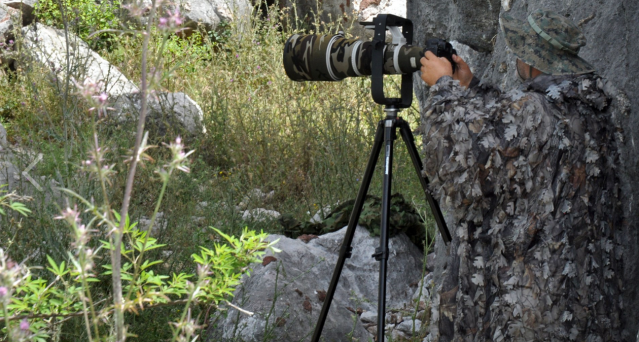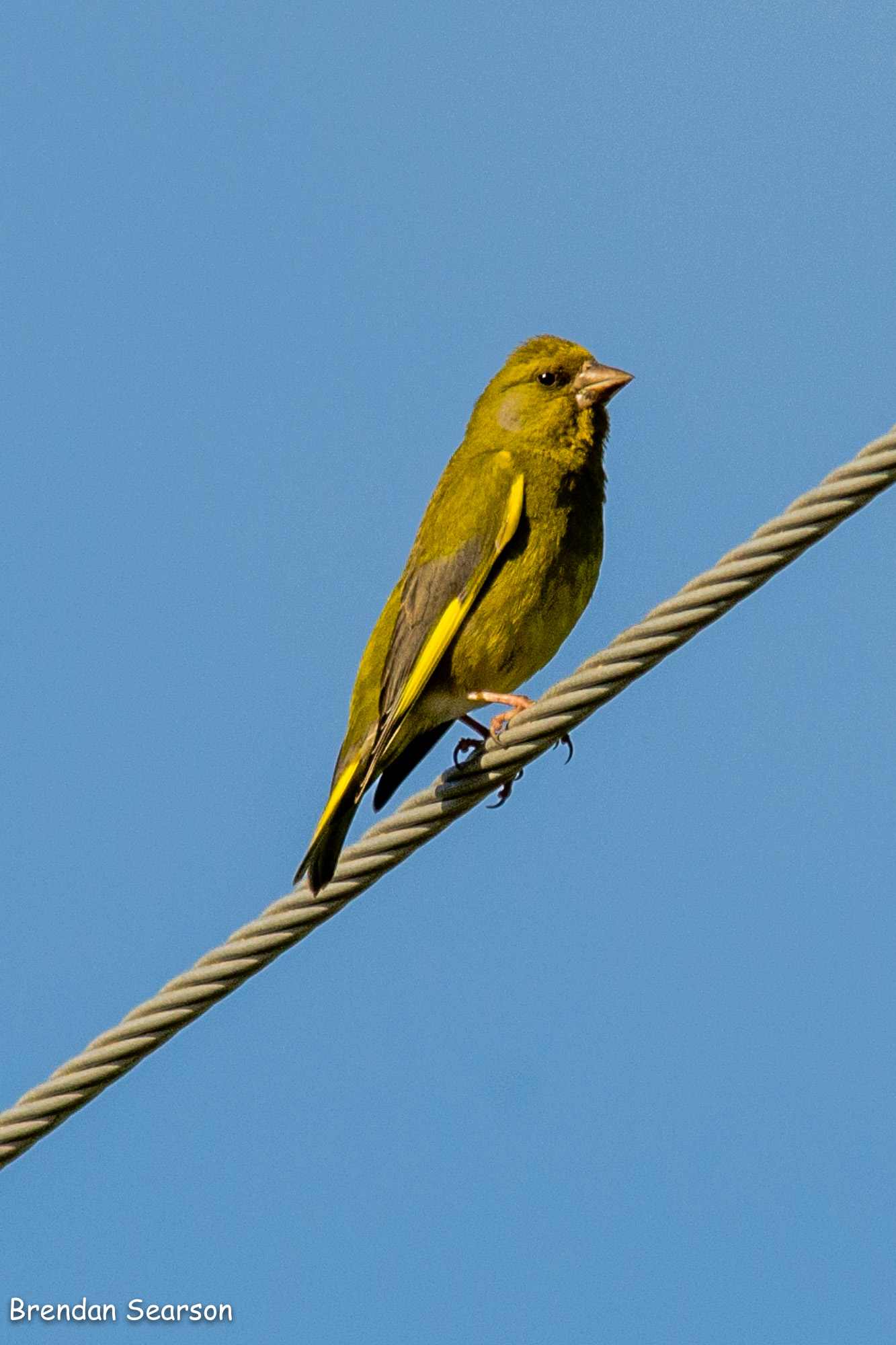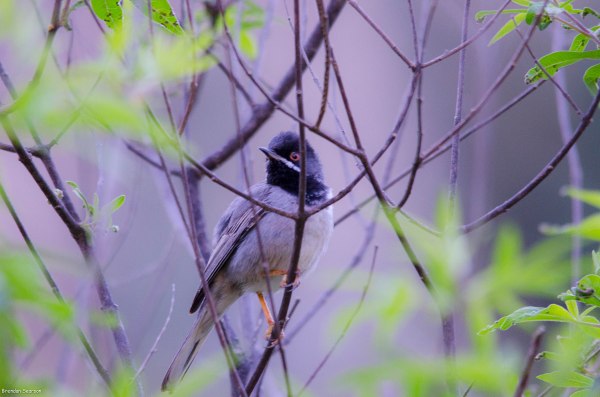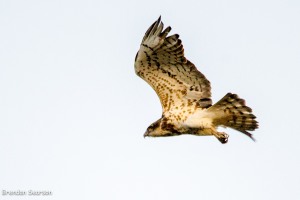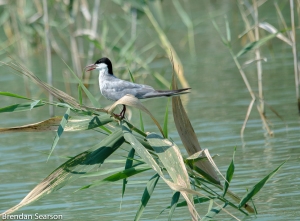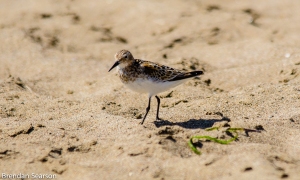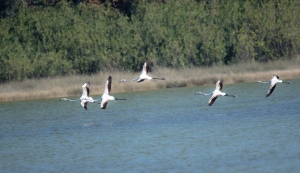Trip report to South West Turkey, April 2015
Dougy Wright and Greg Adams
This was very much a re-run of our enjoyable visit from 10th to 13th April 2014. Once again, we stayed in an apartment at Royal Links, Sarigerme, courtesy of Dougy’s friend Marianne. We visited pretty much the same sites as last year, but at a slightly less frantic pace. Instead of travelling to and from the mountains in one day we stayed overnight at Elmali, and thereby discovered the recently flooded reservoir at Yuva, which was one of the high spots of the trip. The failure of the auto-focus on Dougy’s camera (possibly a consequence of security X-rays) detracted somewhat from his enjoyment of the trip.
Day 1 – Thursday 16th April 2015
We left Sarigerme at 6.30, having seen or heard Cetti’s Warbler, House Sparrow and House Martins. The temptation to explore the marsh was great, but we had decided to get on the road as quickly as possible, and save that for another day. A party of about 26 Little Egrets flew over as we set off. A tight bunch of Spanish Sparrows flew over (the first of many), and within another 100 yards or so we had stopped – despite our resolve to press on – at a pond for Squacco and Grey Herons, Corn Bunting, and White Stork on its nest (one of many up the valley). We drove on a little way picking up Great Tit, Greenfinch, Collared Dove, Hooded Crow and Magpie. Another mile, and our plans to drive on regardless were abandoned. We stopped at random where a small bridge crosses the roadside stream and were rewarded by a Peregrine plucking its breakfast on a nearby pylon, while a total of 9 Corn Buntings were strung along cables nearby. Plenty of Barn Swallows overhead, and also a Jay. The excitement was spoiled, however, by Dougy’s camera failing to operate. We drove on (Crested Lark, dead hedgehog and dead tortoise – we were too squeamish to investigate which species). We had seen a live hedgehog crossing the road on our way from the airport the previous night.
Through Ortaca and Dalyan, and we headed down towards Iztuzu (Red-Rumped Swallow, Blackbird, Yellow-legged Gull). The area after Golbasi restaurant, with salt marshes on one side and cliffs on the other looked brilliant but proved a bit disappointing (Fan-tailed Warbler, noisy Jays, more Little Egret. The stretch of open water beyond was also devoid of water birds, but produced a Chaffinch.
At Iztuzu beach we were greeted by 2 Alpine Swifts, Little Ringed Plover, Turtle Dove and goods views of Spanish Sparrow, Crested Lark and Common Sandpiper in the (still early) morning sunshine. If only the camera were working!
The reed marshes behind the dunes were very quiet compared with last year. On the dunes were a Tawny Pipit and an Isabelline Wheatear with Northern Wheatears close by for comparison. The Isabelline was notably bigger and more broad across the chest when facing us, with more uniform plumage, paler on the mantle, darker below, wings not as dark as the female Northern. Also the stance was helpful to a degree – both species quite upright at times, but the Isabelline consistently so.


Tawny Pipit
Both the Tawny Pipit and the Isabelline Wheatear were very close and quite tame, and the failure of the camera was more distressing than ever. Possibly the result of putting it through the airport X-ray machine with the battery in?? Fortunately the Tawny Pipit was confiding enough to permit a passable record shot with manual focus.
The open water of the marsh near the Dalyan boat trips’ end gave us 3 Sandwich Tern, 5 Black-winged Stilts and also 3 smaller terns too far off towards the dunes to identify at this point. Further on towards the landing area the smaller terns came close (Common Tern), and another LRP and 2 Kentish Plover showed on the beach behind us.

Black Winged Stilt
There were 2 Stone Curlew flying between the beach and the lagoon as we got nearer to the landing area. It was by this time 10.15, and the first 2 tripper boats from Dalyan were arriving as we approached the far end of the beach. A pity, but we had covered most of the beach before any disturbance (apart from ourselves).
Just before the cluster of huts at the landing stage and turtle feeding station was a White Wagtail. Despite the comings-and-goings, 2 Caspian Terns were sat on a sandbar with a group of Common Terns. After we had taken tea and coffee the Caspian Terns had increased to 3 and the Sandwich Terns to 8 or more, coming and going on the same shallow sandbar. A Buzzard flew overhead. The contents of the two boats were ashore but fairly scattered. A Black-winged Stilt could be seen at the end of the sand spit while we were drinking our coffee, despite the “wrinklies” from the tripper boats running and swimming nearby.
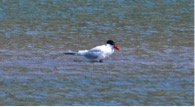
Caspian Tern
Walking back along hard sand along the sea edge was easier and more direct, but fruitless. Greg – as is his wont – soon got bored and re-joined the parallel walk along the dunes and lagoon edge. This also enabled him to walk at his own more serene (some would say more lethargic) pace. We arranged a rendezvous in an hour, but in fact re-joined just a quarter of the way down the beach to re-inspect the Tawny Pipit and Isabelline Wheatear, with a flyover from one of the Stone Curlews. Dougy also re-inspected the Kentish Plovers during his walk down the beach. At the same time as the Stone Curlew passed over, Dougy saw 3 small larks, not close enough to identify as the Lesser Short-toed Larks which he saw last year but which remain absent from Greg’s life list. Greg lagged behind again, but caught up with Dougy three-quarters of the way down the beach, where the latter had found a Short-toed Eagle soaring just above the rocky outlying peak behind the Southern end of the beach.
Iztuzu is certainly a site best visited very early in the day if you intend to walk the whole length of the beach and back. Not just because of the trippers, but also because it is a long hot walk on soft sand once the sun is high. We might have done better to go straight there later in our trip, when we might not have succumbed to the distractions en route.
Unlike last year, when a party of Greater Flamingos had arrived between our outbound and inbound walks, there was nothing new on the lagoon on our eventual return to the Southern end of the beach at nearly 12.30. Greg’s wet feet crossing the stream between the lagoon and the sea were not entirely unwelcome at this stage of the journey.
On the way back over the hill from the beach we saw a Spur-thighed Tortoise on the road, damaged (presumably by a car) but alive, and relocated him to the roadside. Surely they are easy enough to avoid on the road – but I suppose you might say the same about Badgers. We stopped in the roadstone layby at the top of the hill, where Dougy found a pair of Agama (?) Lizards and a male Black-eared Wheatear.
Stopping again at Golasi, we heard again the bird call from the cliffs which defeated us on our last trip. Not Rock Bunting, not Rock Nuthatch, and absolutely no sign of the bird itself. We had brought birdsong CD’s this year, but the bird soon stopped calling and we gave up on it – again. However a Long-legged Buzzard flew over.
We drove into Dalyan looking for somewhere to have Dougy’s camera repaired or replaced, but without success. There was a photographer’s studio, but he sold very few cameras. As a small consolation, a Purple Heron flew by as we drove along the waterfront.
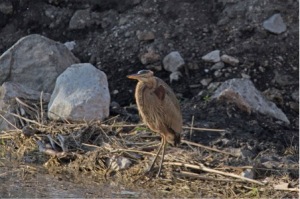
Purple Heron
House Martins were around the town. Lunch at the Ocean Garden restaurant was excellent (possibly the best meal of our trip), and a White Stork was stalking in a field as we left the town, headed to Koycegiz via Eskikoy. This is en route to the Liquidambar forest, but in the heat of the afternoon (3.00.p.m.) we did not think that would be worth a visit. After Tepearasi we drove alongside the Liquidambars for a few hundred yards, and very beautiful they looked as a destination for another day or year. At the next village (no sign seen) we stopped where the road crosses a stream, expecting Bee-eaters and seeing instead Goldfinch, Common Whitethroat and a delightful baby tortoise. Just before the main road junction at Beyobasi we heard Nightingales in the citrus groves on both sides of our by-road. At the junction we turned right, not by choice but knowing it would take us to flooded fields on the far side of the hill. Dropping down on the new road we took the first right at the bottom, past a cemetery for old (mostly American) cars and trucks. Forking right around the marble works, we crossed a flat valley bottom picking up 3 Whinchat, 21 soaring White Storks, more than 40 Yellow-legged Gulls and a Woodchat Shrike on the way. The flooded field is a good deal more flooded than last year. It now has furrows rather like Ryan’s Field at Hayle, and seems to have been cropped with maize. It contained a load of Black-headed Wagtails (10 plus) and a ticking Olivaceous Warbler just beside the track. A little further on a ditch alongside the road was seething with huge (two inch plus) fat tadpoles, in an almost solid mass in places. From the causeway leading back towards the main road we inspected the flooded area carefully. Plenty of White Storks (15 on the ground at one point) but no Black Storks today, unlike last year. 3 Cattle Egrets were present.

Black Headed Wagtail
Turning left up the lane on the far side of the causeway we ran into agricultural land and hillside, following the river which held another Eastern Olivaceous Warbler. The river held large numbers of frogs, mostly with a yellow strip down the spine, but one brighter green with a “flowery” pattern, and also Stripe-necked Terrapins all along one section of bank, all just above the waterline. Eventually this track led us back onto the Ortaca road. Totally disorientated, we turned left, went through Ortaca, making a complete circle, and re-joined the D400 heading North West towards Koycegiz. Our lunchtime restaurateur had recommended turning right at Beyobasi up the riverside track towards Yukarcal as a pretty and birdy route. Another possibility for another day. By this time (going on 5.00.p.m.) the B400 was very busy, and enlivened by mopeds riding the wrong way on our nearside verge and also, in one case, along the central reservation.
After taking the left turn left to Koycegiz, the driving calmed down. At the roundabout we turned left through the town until we reached the lakeside, then turned right and stopped half a mile out, near the Delta Plaji. There was more water, but fewer waders, in the river than last year. There were 4 LRP’s making a great fuss, and 1 more peaceful 1 Common Sandpiper. A man fishing in traditional fashion, with a weighted cast-net, was the most interesting sight. A Little Gull and a Squacco Heron on the seaward side seemed a reasonable end to the day, although 11 hours and 54 species seemed a bit lightweight compared with last year. A delightful collie-cross with 4 big pups reminded us that Dougy had forgotten the dog biscuits in last night’s shop. On the way back a hazardous stop on the hard shoulder of the D400 to look over the flooded fields filled in the missing Black Storks (2). Common Swift as we returned to the apartment exactly 12 hours after departure rounded off the day’s work. Dougy logged Water Rail while Greg was in the shower. Sneaky!

Squacco Heron
Amazingly, the owner of the bar where we ate last night and drank tonight has offered Dougy the loan of his Canon camera and 70-300mm lens. Unfortunately we will not be able to pick it up tomorrow as we are leaving early. We ate this evening (as last year) at an unnamed restaurant – very traditional, no alcohol served or allowed. Interestingly, the bag of dog biscuits bought to ingratiate ourselves with the village dogs on our travels (nearly 30 Lira) cost more than tonight’s meal for two (27 Lira). A Tawny Owl was calling (or possibly 2) as we finished our meal there.
Day 2 Friday the 17th April 2015
Preparations for the planned overnight stay in Elmali provided extra faffing opportunities, but we were on the road by 6.15.a.m. We proceeded without hesitation or deviation to the B330 and up into the foothills, before stopping at an attractive parking area with a mountain river and a stone built byre and other farm buildings. A conspicuous Black-eared Wheatear, a selection of finches and tits including Coal Tit, and the first Cretchzmar’s Bunting of the holiday. Onward and upwards over the next brow (1300 metres) and we saw our first destination, the reservoir and plain West of Seki. We followed a track away from the road in a very active area of grass and small trees, for Serin, Woodlark, Cirl Bunting, Willow Warbler, Chiffchaff, Common Whitethroat, Black Redstart, 4 Eastern Orphean Warblers obligingly squabbling in a leafless bush, a Starling, a Lesser Whitethroat, Long-tailed Tit, Wood Warbler, a pair of Sombre Tit, Black-eared Wheatear, Jay, and Ruppell’s Warbler. There was extensive evidence of wild boar excavation as we got further from the road.

Cretchzmar’s Bunting
Then down to the reservoir proper – turn off at the Tepe Restaurant. A sign suggested that the reservoir may be called the Baraj Sahasindan, but that might equally be some sort of warning or information – a phrase book and a few nights with a Turkish language CD didn’t enable us to translate. Far more water than last year and no stony margins. We walked part-way round, seeing an LRP on the remaining patch of mud in one corner, 5 Great Crested Grebes, a pair of very cross LRP’s at one point (suggesting we must be close to their nest) a Grey Heron. 12 Great Cormorants, and a Common Whitethroat. Also a large (very large) spider in a tunnel with a built-up rim of twigs. Grey-brown and barred on the back, orange yellow underneath.
On to the Seki plateau. The first fenced field on the left (which provided Calandra Lark last year) provided two Isabelline Wheatear and singing Crested Lark. We drove slowly around the Seki plateau for a while, but added nothing else to our list except Linnet. We then began to climb up through Seki (starting to look for Red-fronted Serins) though the first bird of note was a Nightingal
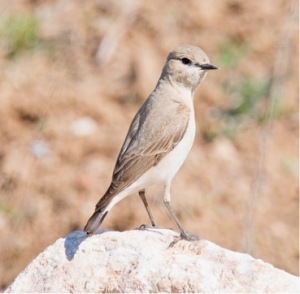
Isabilline Wheatear
We stopped at an attractive area of alpine meadow above Seki seeing another tortoise (we had also lifted one to the side of the road down on the plateau). It turned out that we saw tortoises on every day of our trip, both Spur-thighed and Hermann’s. Also around the alpine meadows were a Northern Wheatear, Ruppell’s Warbler, and White-throated Robin. Unlike last year’s unco-operative birds, this one was in full view, singing and using a leafless tree as its base, fly-catching and feeding on bare ground, and posing for the camera and telescope on the top of Berberis bushes. Having tuned into the song, we worked out that there were probably 4 around us, two of which had a minor scuffle but soon returned to posing.

White-throated Robin
We walked up to the ridge, and liked the look of the next plateau beyond. Walking back down we saw all the above again, plus Cretchzmar’s Bunting, another tortoise,
5 Red-billed Choughs and on the lower slope close to the road a mixed flock of Linnets, Goldfinches and two Red-fronted Serin. Having already achieved the main target species of the high slopes and pass, we decided to have a look at the next plateau before going “over the top”. So, instead of going straight up the D48 – 30 we turned left down a dirt road towards Keyobasi. The landscape did not seem as attractive from ground level as it had from above, being quite intensively farmed with liberal applications of a blue insecticide or fungicide to the young fruit trees. The area yielded Jay, Skylark, Cretchzmar’s Bunting and best of all a very obliging Cetti’s Warbler in full view.

Chough

Northern Wheatear
Back to the D road through Zorlar. Male Lesser Kestrel as we left the village, followed almost immediately by a nice ginger-tailed Long-legged Buzzard, another Lesser Kestrel ( or possibly the same). Then a mammal the size of a Suslik but with a short but bushy tail. We stopped at the Mescid for a cup of tea, to the accompaniment of Red-billed Chough, Rock Bunting, Eastern Rock Nuthatch, Wren, Raven, and an even bigger tortoise.
Onward and upward into snow and up to the Gogubeli pass (1850 metres). Another Lesser Kestrel, Red-billed Chough, Rock Nuthatch, Northern Wheatear, Black-eared Wheatear, Common Whitethroat, 3 Mistle Thrushes, 2 Blue Rock Thrushes (male and female), Hoopoe, and 2 Rock Thrushes (male and female).

Eastern Rock Nuthatch

Rock Thrush
We then dropped down slowly to Yaprakli, picking up a few more of the same including 2 more Red-fronted Serins at the roadside 400 yards above that village. Rock Nuthatches, with their penetrating call, were quite frequent; 2 posed for a photo just below Yaprakli Bridge, by which point the river was a fast-flowing torrent, probably with the last of the snow melt. We were in no hurry at this point, not having to drive back to Sarigerme tonight. Dougy also saw a Red Squirrel. In Yalnizdam an apparent Great Spotted Woodpecker flew across the road and landed on a drilled-out telegraph pole briefly before flying away. In the hope of it being a Syrian Woodpecker (new for Greg) we waited and it returned once, briefly, but on both occasions it seemed to show a lot of red under the tail. We waited with scope trained on the post (not easy with a monopod) but it did not oblige. Meanwhile Dougy walked closer, got another view of the Woodpecker, and also 3 Tree Sparrows plus Spanish Sparrows. We gave up on it, headed on South a short way, but decided to come back and give it longer. A 20 minute stakeout failed, and Greg was just walking back to the car when the Woodpecker reappeared and perched on a different pole. It was a little further away, but with lots of red and no sign of a gap on the head pattern, so we came to the reluctant conclusion that it was Great Spotted in the short time before it flew off.
We drove on, and then things really livened up. As we approached Yuva, Dougy saw a large cloud of dark birds high in the sky over Yuva reservoir (which we did not know existed). We drove down beside it and found Ruddy Shelducks, Mallard, and the cloud of 60 birds, still flying high but identifiable as Glossy Ibis. Birds were all around – Yellow Wagtails, Corn Bunting, the Glossy Ibis flying higher, it was difficult to know where to look. A little further on, Little Grebe were also seen, and it became obvious that we must get on to Elmali, check in, and get out here as quickly as possible tomorrow. This lake is also obviously newly flooded, with mature trees growing out of the water and coming into leaf.

Yellow Wagtails
We drove onto Elmali and found, more by luck than judgment, the Tu-ba hotel. When we went out for a meal a Little Owl was calling, and still calling when we came back.
Day 3 Saturday the 18th April 2015
First stop the Yuva reservoir. A Night Heron as we driving around the lake was a really good start with a Hoopoe calling as we watched. The heron was an excellent spot by Dougy in the lower branches of one of the flooded trees as he drove along (eyes on the road!) looking into the just-rising sun. This was followed within 30 yards by a Purple Heron at the waterside and a Grey Heron flew past to complete the set. A pair of Moorhens were next. We stopped beside a flooded house and in a lagoon separate from the main lake was a female Gadwall. Next was a line of reeds separating the feeder stream from the main lake, which contained a singing Reed Warbler. There was a little cluster of trees next (beyond the top of the lake) and one in particular of these was alive with birds, numerous Reed Warblers but also a Penduline Tit, Icterine Warbler, Cetti’s Warbler, Blackcap and Goldfinch. We went back to the flooded restaurant and saw a pair of Garganey.

Night Heron

Garganey
We drove up and down the lakeside a couple of times. Dougy manually focused on Purple and Squacco Heron side by side, with a Black-headed Wagtail in the foreground. Meanwhile Rock Nuthatch, Black-eared and Northern Wheatear were on the slope on the other side of the road.
Back to the warbler hotspot, which was still active. A Moustached Warbler skulking along the bottom of the reeds, and occasionally showing well in the base of the Willows, was a “lifer” for Greg. A Lesser Kestrel flew in and perched briefly at the top of one of the Poplars. Back along the lakeside again and 3 Night Herons perched on the trunks of flooded trees, watching with interest the spawning Carp below. As we decided to leave we passed a Long-Legged Buzzard perched on the ground, which flew idly across the road and posed on a treetop 35 yards from the road. On the way up to the mountains Dougy heard and saw a Wryneck at Eskihasar. Just up the hill we stopped again for Crag Martin and Scarce Swallowtail.
Back up to Gogubeli pass. Much the same as yesterday apart from a tortoise, even up here among patches of snow. Starting on the descent we saw Black Redstart. Having descended safely to the Seki plain and taken the left towards Girdev we saw Common Redstart, male and female, and Nightingale showing as well as singing.
Back at Sarigerme we spent the last of the afternoon covering the flooded fields and river, and the ponds and expanses of sand which remain from the (temporarily) abandoned project to create a golf course. The additions to our list were Kingfisher, Roller, 2 Little Bittern plus a Sawfly Orchid and a Four-spotted Chaser dragonfly, Marsh Harrier, Sedge Warbler and Great Reed Warbler.
Day 4 Sunday the 19th April 2015
The day started slowly. Two hours spent on the golf course and hill produced 2 Bee-eaters but nothing else new. We stopped for an unfamiliar call which turned out to be Spanish Sparrow in the base of a stork’s nest, but the false alarm benefited us with a basking Montpellier Snake artfully arranged on a bicycle seat with a pile of other rubbish in a stream bed. Turning seaward just before Beyobasi traffic lights, we walked down the bank of the river which feeds Lake Koygeciz .
Lots of orange groves, and another Roller when we parked the car. Green Woodpecker calling across the river. We crossed the rickety footbridge to the grove of trees and buttercup fields which served us well last year, and immediately got Icterine Warbler and Collared Flycatcher (a striking male). Then Lesser Spotted Woodpecker, more Nightingales (one sang briefly from an overhead wire) Willow Warbler, Blackcap, and a Glossy Ibis. Where the river started to slow near the lake we flushed 4 Green Sandpiper, and at the mouth of the river we found 9 Black-headed Gulls and a Black-winged Stilt on a sandbar, a Common Sandpiper flying past, and a Whiskered Tern perched on a branch or pole a little way out. Most of the lake is reed-fringed at this point and a tiny sandspit and a “doom bar” right across the river mouth are the only visible wader habitat.
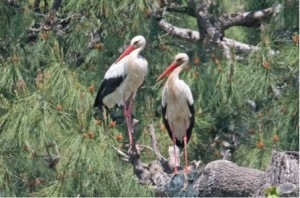
White Storks
On the way back, Lesser Whitethroat, Eastern Olivaceous Warbler, male and female Blackcap, and an Olive-tree Warbler, much larger than the Blackcaps sharing the same tree, and aggressive towards them.
Back at the warbler hotspot were two Stripe-necked Terrapins, but we were hot and weary so did not linger long. On the way back one of the nesting Storks was bill-clapping, and another Roller flew over as we arrived back at the car.
Back again to Beyobasi and we turned right towards the hills. Where the road ran alongside the river we stopped and saw Grey Wagtail, and a mile or so further up we stopped under a tree in which a Kruper’s Nuthatch was constantly calling. The tree was very tall, and despite the calls it was impossible to see the bird from directly below. Dougy had a brief glimpse by climbing up the bank opposite, before the bird flew slightly further away and lower. At the same point we also picked up a Ruppell’s Warbler on a telegraph pole. The Kruper’s moved around constantly calling, and eventually took pity on Greg’s aching neck, and flew down low to the trunk of a tree near the road. Then, crossing the road, the first tortoise of the day – later than usual at 2.15.
We drove up as far as Alan and stopped down on the fertile plateau. Hoopoe, lots of Swifts, Masked Shrike, and Eastern Festoon, but no Wheatears, Finsch’s or otherwise. On the descent another (bigger) tortoise was in the same spot but on the lower side of the road, explaining why the first was trying to cross the road until I took him back whence he came.
About 3KM down from Alan we had excellent views of a male Wheatear on the roadside fence post above one of the few bare areas of ground. Absolutely no gap between the black on the deep throat patch and that on the wing. However, owing to a yellowy tinge on the head and nape we reluctantly logged it as Black-eared not Finsch’s. With the benefit of hindsight and a guide book, the head and nape colour doesn’t rule out Finsch’s and the bird was probably of that species. We’ll have to go back and check! 2 Black Storks were also rising past us at this point.
We drove on down to the flooded fields where the population was much the same apart from a Lesser Emperor dragonfly, a Lesser Black-backed Gull and 15 Wood Sandpiper. A quick look at the beach at Sarigerme added Jackdaw and Rock Dove as a slightly unexciting finale to the list. The latter looked pure-bred, although the fact that there is a dovecot in the gardens behind the beach might make them unacceptable to more scrupulous recorders. We will be back!!

Wood Sandpiper
